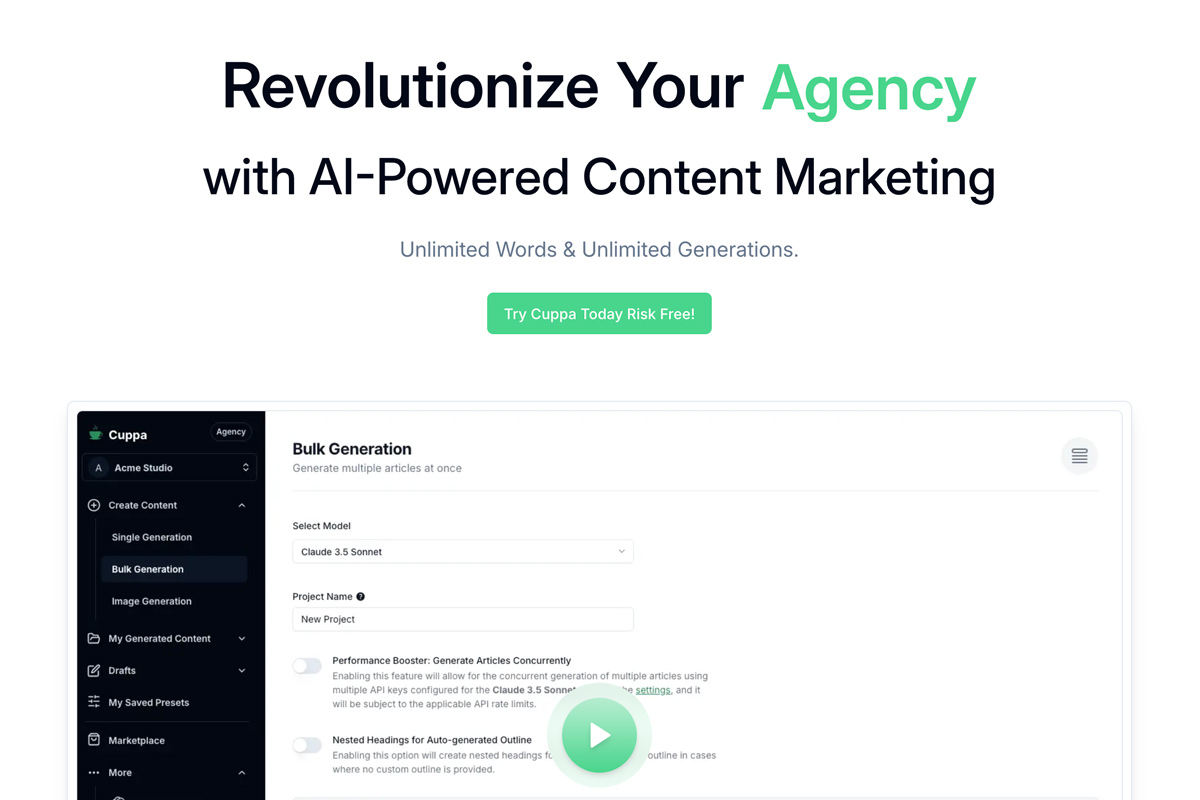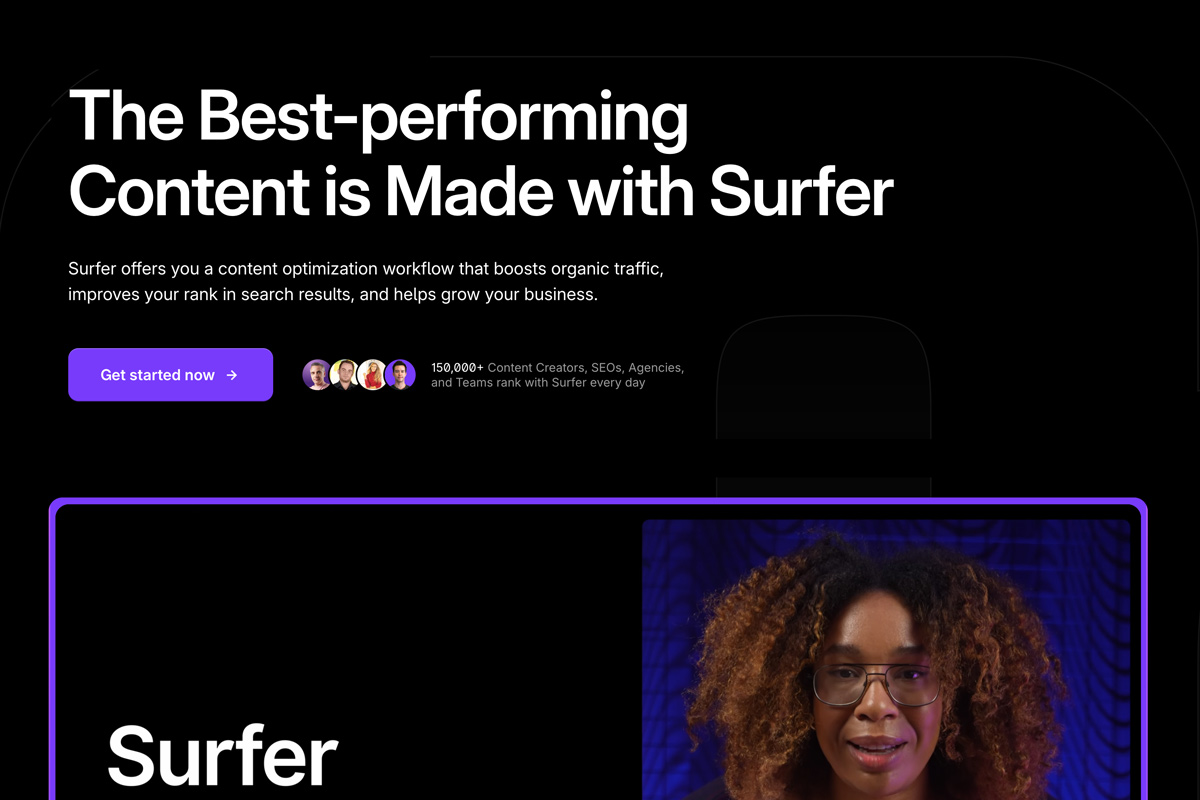AI content writing platforms have entered their enterprise era. Today’s top tools are full-fledged workhorses—powering SEO campaigns, scaling editorial operations, and replacing entire workflows once spread across research, writing, and optimization tools.
But with dozens of AI writers on the market in 2025, which ones truly deliver when it comes to producing content that ranks?
We tested and compared three of the best AI content writing tools for SEO-driven teams: Cuppa.ai, Frase.io, and SurferSEO. While each tool targets a slightly different use case, all three are leaders in combining artificial intelligence with real-world publishing needs—especially for teams trying to balance scale, quality, and search performance.
This guide covers how each platform works, what kinds of content it excels at, and how it compares in areas like SEO integration, workflow support, editorial control, and team collaboration.
Whether you’re building programmatic location pages, researching long-form content briefs, or trying to push an under performing post up a few positions on Google, there’s likely a clear fit among these contenders.

Cuppa.ai: Bulk Content Production With Control and Customization
Cuppa.ai is one of the most execution-oriented tools on the market. It was clearly designed for content teams who need to produce a lot of content fast—especially in structured formats like local SEO pages, ecommerce descriptions, or programmatic blog templates.
At its core, Cuppa lets you feed in structured data—like a spreadsheet of keywords or product names—and outputs fully formed drafts in bulk. Its five-step generation process lets you define tone, context, voice, and desired length. Unlike most AI writers that treat each article as a standalone prompt, Cuppa’s interface is built for scale: users can upload dozens or hundreds of prompts and run them all at once.
Cuppa also supports image generation through integrations with Midjourney and Flux, which means you can create both text and visual assets in a single workflow. For SEO agencies producing top-of-funnel blog posts, city-level service pages, or ecommerce category intros, this saves time and minimizes creative bottlenecks.
In terms of SEO integration, Cuppa doesn’t aim to replace Surfer-style score-driven tools, but it does offer competitive keyword usage, real-time SERP scraping, and the ability to define which results the AI should mimic. While it doesn’t calculate a content score or analyze 500+ ranking factors, it does pull meaningful on-page cues from competitors and incorporates them into your draft structure.
From a team standpoint, Cuppa offers a GitHub-style project hierarchy with support for cross-team collaboration, role-based access, and shared content libraries. Agencies can white-label outputs, centralize client deliverables, and use templates across projects.
One of the more unique things about Cuppa is its BYOK model—you can bring your own OpenAI or Anthropic API keys. This gives you flexibility over which LLM you use, and in some cases, allows for significantly lower cost per word compared to tools that charge per generation. However, pricing at scale can vary depending on your actual usage and model settings, so while lower usage plans may be quite cost-effective, high-frequency teams should still monitor token costs carefully.
Cuppa isn’t trying to be the most feature-rich or polished tool on the market. What it does offer is velocity—fast, structured, and flexible AI writing for teams that know their workflows and want to automate them.

Frase.io: The Research-Driven Content Strategist
Frase.io operates at a different altitude than most content tools. It’s not just a writer—it’s a researcher, a strategist, and a semi-automated editorial assistant rolled into one. The platform’s strength lies in its ability to synthesize competitive data from the SERPs and convert that into detailed article briefs, outlines, and optimized drafts.
Frase begins by pulling in the top 20 results for any given keyword. It then analyzes the structure, language, subheadings, questions, and common themes across those results. This gives you an instant snapshot of what Google thinks is relevant for that topic—and how your competitors are framing it.
Once the data is loaded, Frase walks you through a step-by-step workflow to build out a content brief. You can insert suggested headers, import competitor FAQs, and generate AI-written drafts that reflect the dominant themes of the SERP. The Article Wizard even lets you select which competitor styles to emulate, which can result in more SERP-aligned output than general-purpose AI tools.
Frase’s editor is split-pane: you get a content writing space on one side, and a dynamic research panel on the other. This makes it easy to cross-reference live SERP data while writing. The AI is always on tap—ready to write introductions, complete sentences, or draft entire sections based on context.
On the collaboration side, Frase supports shared document folders, in-line comments, and permission controls. Google Docs integration is solid, and teams can review and iterate without breaking formatting or losing track of edits.
Frase also includes a powerful content optimization engine. Once a draft is complete, it scores your text based on keyword coverage, topic depth, and structural alignment with top-ranking competitors. You can make improvements on the fly, and the score updates in real-time.
For SEO teams that value structure, research, and editorial rigor, Frase is an ideal assistant. It doesn’t just guess at what to write—it shows its work. You still need human editors for final polish, but as a way to compress research and first-draft creation into a single interface, Frase delivers consistently useful results.
Its only real downside is scaling. Since plans are tied to document credits, teams with high throughput may find themselves bumping up against usage caps or having to upgrade plans more often than expected. And while the UI is feature-rich, it can feel heavy if you’re working on dozens of pieces at once.
That said, Frase is a highly capable tool that helps SEOs connect intent, structure, and search visibility in a way that few other platforms can.

SurferSEO: Optimization First, Content Second
Where Cuppa and Frase focus on content creation, SurferSEO is squarely focused on optimization. It’s not a general-purpose AI writer, and it doesn’t try to be. Instead, it offers one of the most precise, data-driven SEO editors on the market.
The premise is simple: input a keyword and a draft, and Surfer will analyze that content against 10–20 of the top-ranking competitors in Google. It then provides a comprehensive report on how well your content aligns with key on-page ranking factors: keyword usage, structure, semantic depth, image count, paragraph density, and more.
The centerpiece of Surfer is the Content Score—a live indicator that tells you how close your content is to SEO ideal for that topic. The editor suggests keywords to include, phrases to avoid overusing, and even how long each section should be. As you edit, the score updates, encouraging iterative improvements.
Surfer has added content generation tools (via Surfer AI), but its real power is in refining and improving drafts that have already been written. Whether your content is AI-generated, written by freelancers, or pulled from an existing knowledge base, Surfer helps you reshape it to match what Google is rewarding.
For technical SEO teams, Surfer includes tools like Grow Flow (a task system that delivers weekly SEO suggestions), an internal linking module, and integrations with Google Docs, WordPress, and even Jasper.ai for joint optimization and publishing.
It’s a strong fit for teams that already have content assets and want to make them rank higher. Many SEO consultants, agencies, and in-house strategists use Surfer not to write content—but to grade and guide it.
In that regard, Surfer fills a very different niche than Cuppa or Frase. It’s not built to ideate. It’s built to improve. And in terms of sheer analytical depth—517 on-page factors, NLP entity scoring, semantic gaps—it’s still one of the most technical tools available.
The drawback is that Surfer’s editor can be time-intensive to use at scale. Each piece must be run individually. And because pricing is based on credits for documents or AI generations, large teams may face steep costs to maintain throughput. Surfer is an investment in precision, not speed.
Still, if you need to push a post from page two to page one—and have the time to work through granular on-page improvements—Surfer is hard to beat.
Which Tool Is Right for Your Team?
If you’re looking for a one-size-fits-all AI writer, none of these tools are perfect. But if you’re willing to align your choice to your workflow, each of them becomes extremely powerful.
Choose Cuppa.ai if you:
- Need to produce dozens or hundreds of SEO pages fast
- Have structured data like keywords or product specs you can feed in
- Want control over LLM choice and pricing via API key usage
- Value speed, programmatic workflows, and simple bulk ops over granular SEO grading
Choose Frase.io if you:
- Value SERP-driven research and topical authority
- Want an assistant that helps plan, outline, and draft with context
- Work in client SEO, editorial strategy, or content marketing
- Need team collaboration features like document sharing, commenting, and version control
Choose SurferSEO if you:
- Already have drafts or content assets and want to make them rank
- Care about NLP optimization, internal linking, and technical audits
- Want precision scoring and competitive benchmarking
- Don’t mind slower workflows in exchange for better ranking outcomes
There’s no silver bullet here—but there is alignment.
The best AI content writing tool of 2025 depends on how your team works, what kind of content you’re producing, and how close you are to the outcomes you want.
If you’re in the ideation and production phase, tools like Cuppa and Frase offer serious advantages. If you’re past that and ready to optimize and grow traffic, Surfer becomes essential.
For many SEO teams, the answer may not be one tool—it may be a combination. Generate with Cuppa, brief with Frase, and refine with Surfer. Or lean into one depending on the stage of your workflow.
What’s clear is this: AI tools in 2025 are no longer about automation alone. They’re about control, customization, and outcomes.
The tools that help you bridge the gap between speed and search visibility—the ones that make your content not just publishable, but performant—are the ones that will win.
And these three platforms are at the top of that list.
Feature Comparison: Cuppa.ai vs. Frase.io vs. SurferSEO
| Category | Cuppa.ai | Frase.io | SurferSEO |
|---|---|---|---|
| Review Overview |
Pros: Fastest for bulk content, clean UI, API-friendly, extremely low cost per word Cons: Can require GPT keys, not great for live on-page edits, image gen gated to top tier |
Pros: Superb for content briefs, real SERP context, balances automation & research well Cons: UI can feel clunky at scale, credit-based billing is painful for agencies |
Pros: Best-in-class scoring engine, internal linking tool praised by technical SEOs Cons: Most expensive, collaboration feels dated, lacks programmatic content creation options |
| Supported Content Types | Programmatic SEO pages, bulk local pages, ecommerce variants, service landing pages | Long-form blog posts, SEO briefs, thought leadership content | SEO-optimized long-form posts, audits, landing pages |
| SEO Features | No-code programmatic SEO, real-time competitor scraping, TF-IDF scoring | SERP ingestion (top 20 results), keyword/competitor gap analysis, topic scoring | 500+ ranking factors, internal linking, NLP scoring, auto-optimize engine |
| Content Quality Controls | Multi-stage “humanization”, 33-language support, GPT + Claude switching | SERP-aware AI writing, tone selection, readability scoring | Readability & NLP optimization, AI Humanizer, SEO content score |
| Workflow/Collaboration Tools | GitHub-style folder hierarchy, cross-project content libraries, user permissions | Shared folders, comments, history tracking, team roles | Limited collaboration; mostly single-user editing with basic roles |
| Prompting UX / Interface | Template marketplace, chat + doc interfaces, spreadsheet import for bulk creation | SERP visual panels, AI content wizard, inline editor | Surfy Assistant (doc editor), content dashboard, template-based scoring |
| WordPress / Publishing Integration | 1-click WordPress publishing, Zapier, CMS API connectors | WordPress plugin with real-time topic scoring | Google Docs/WordPress export, no native publishing |
| Image & Media Support | Midjourney + Flux image gen integrations (Power tier) | Light visual embed support only | No generation; SEO media checks only |
| Pricing & Limits | $15–$150/mo (unlimited use if BYOK), bulk ops, multi-user included | $44.99–$114.99/mo, limited by doc credits & seats | $59–$199/mo, per seat, limited content credits, extras like Grow Flow sold separately |

